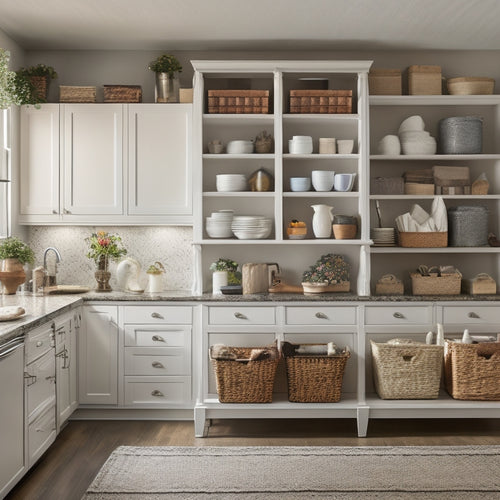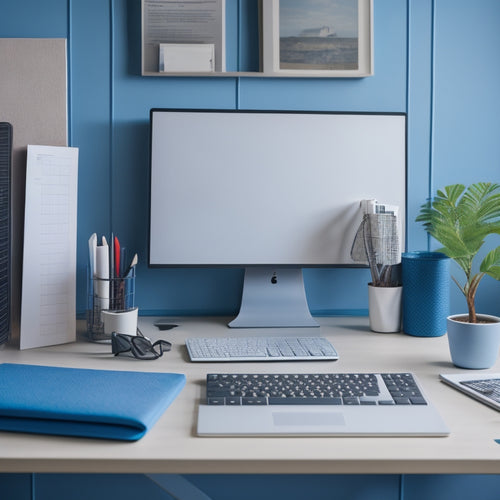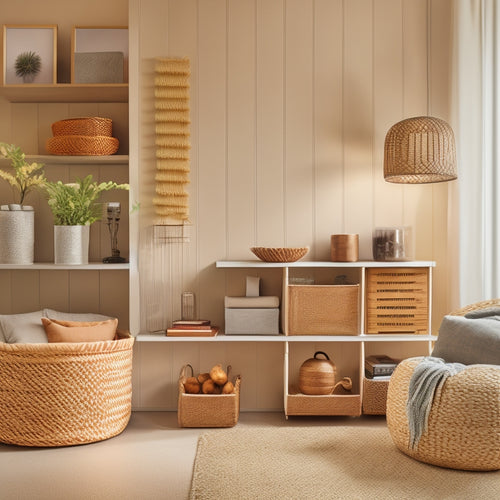
5 Essential Tips for a Clutter-Free Home Storage
Share
You're just a few simple changes away from enjoying a clutter-free home, where everything has its designated place and you can finally find what you need when you need it. Start by decluttering and assigning a home for each item, then utilize vertical storage spaces and implement a maintenance routine to keep clutter at bay. Investing in multi-functional furniture can also help optimize storage. To take your clutter-free journey to the next level, focus on creating a tailored system that truly works for you and your unique needs - and discover the freedom that comes with a space that truly serves you.
Key Takeaways
• Declutter before organizing by categorizing items into keep, donate/sell, and discard piles to create space for what truly matters.
• Assign a home for each item by designating a specific place and using storage containers and a labeling system for easy identification.
• Utilize vertical storage spaces by maximizing storage capacity above kitchen cabinets, behind doors, and with floating shelves.
• Implement a maintenance routine by setting aside time each week for regular assessments, cleaning, and labeling to prevent clutter buildup.
• Invest in multi-functional furniture that optimizes storage space with dual-purpose designs and hidden compartments for a clutter-free home.
Declutter Before You Organize
You'll often find that decluttering is the most critical step in achieving a clutter-free home, as it lays the foundation for effective organization and storage. By prioritizing decluttering, you'll be able to identify what's truly important to you and what can be let go of. This process allows you to focus on what adds value to your life, rather than holding onto items that no longer serve a purpose.
The benefits of minimalism are numerous, from reduced stress and anxiety to increased productivity and a sense of freedom. When you surround yourself with only what's necessary, you'll find that you're more focused and intentional with your time and energy. By letting go of the unnecessary, you'll create space for what truly matters.
As you begin the decluttering process, start by categorizing items into three piles: keep, donate/sell, and discard. Be honest with yourself about each item, and don't be afraid to let go of things that no longer bring you joy or serve a purpose. Remember, the goal is to create a space that feels peaceful, functional, and reflective of your personal style.
Assign a Home for Each Item
With your decluttered space in hand, it's time to designate a specific place for each item, ensuring that everything has a logical and convenient home. This is where the magic of organization happens. You'll create a system that makes sense to you, so you can easily find what you need when you need it.
Start by categorizing items into organizing zones, like a 'launching pad' for your keys and wallet or a 'crafting corner' for your art supplies. Within these zones, use storage containers and a labeling system to keep similar items together. Consider color coding your labels to visually distinguish between categories.
For example, use blue labels for office supplies and green labels for kitchen utensils. As you assign a home for each item, think about how you use it and how often you need it. Store frequently used items in easy-to-reach locations, and reserve higher shelves or harder-to-reach areas for less frequently used items.
Utilize Vertical Storage Spaces
Maximize your storage capacity by capitalizing on often-overlooked vertical spaces, such as the area above your kitchen cabinets or the space behind a door, to stash less frequently used items. This will help you make the most of your home's storage potential without taking up valuable floor or counter space.
Over the door racks, for instance, are perfect for storing items like jackets, bags, or cleaning supplies, keeping them organized and easily accessible. You can also install floating shelves in areas like the living room or bedroom to display decorative items or store books, keeping them tidy and out of the way.
When utilizing vertical storage spaces, consider the items you need to store and choose the right solution accordingly. For example, if you have a lot of long, thin items like brooms or mops, look for a tall, narrow storage unit that can accommodate them.
Implement a Maintenance Routine
To maintain your newly organized space, set aside 10-15 minutes each week to tidy up and safeguard everything remains in its assigned spot. This regular maintenance routine will prevent clutter from building up again.
During this time, perform regular assessments to identify areas that need attention. Check your organizational bins to confirm they're still serving their purpose and make adjustments as needed.
Create a cleaning schedule that suits your lifestyle, focusing on high-traffic areas and tasks that require frequent attention. Implement a labeling system to help you quickly identify what's inside storage containers and bins. This will save you time and effort in the long run.
Invest in Multi-Functional Furniture
You can optimize your storage space by incorporating multi-functional furniture pieces that serve dual purposes, such as an ottoman with built-in storage or a desk with a hinged top that reveals a hidden compartment. This approach not only saves space but also adds a touch of innovation to your home decor.
Look for space-saving solutions that combine functionality with style, like a coffee table with storage bins or a Murphy bed with built-in shelves.
When selecting multi-functional furniture, consider customizable options that cater to your specific needs. For instance, a bookshelf with adjustable shelves or a storage bench with removable cushions can be tailored to fit your unique requirements.
Innovative designs often feature hidden compartments, which can be used to stash away items like linens, cleaning supplies, or even valuable documents. By investing in multi-functional furniture, you'll be able to create a clutter-free home that's both functional and aesthetically pleasing.
Frequently Asked Questions
How Do I Handle Sentimental Items I Don't Want to Get Rid Of?
When sentimental decluttering feels tough, acknowledge your emotional attachment and consider storage solutions that allow you to keep memories without the clutter, like digitizing photos or creating a sentimental item storage box.
What if I Have Limited Budget for Storage Solutions?
Like a puzzle, you're trying to fit storage solutions into your tight budget. You can DIY solutions like repurposing items, or utilize space by getting creative with organizing. Secondhand options can also help you save while staying organized.
Can I Still Have a Clutter-Free Home With Kids?
You can still achieve a clutter-free home with kids by organizing toys into labeled bins and creating kid-friendly systems that encourage independence, making it easier for them to maintain their own spaces.
How Often Should I Reassess My Storage Needs?
You should reassess your storage needs every 3-6 months to verify it's aligned with your changing needs, incorporating storage rotation and decluttering to maintain a minimalist organization strategy that works for you.
Are There Any Eco-Friendly Storage Options Available?
"Measure twice, cut once" when exploring eco-friendly storage options. You'll find sustainable solutions using biodegradable materials like bamboo, recycled cardboard, or repurposed fabric, allowing you to reduce your carbon footprint while keeping your space organized.
Related Posts
-

3 Essential Tips to Boost Home Storage Capacity
You're one step away from freeing yourself from clutter chaos! To boost your home storage capacity, start by purging ...
-

Master Home Organization With These 5 Online Courses
You're about to gain control over your living space with an all-inclusive education in home organization, courtesy of...
-

Effortless Home Organization Systems for Busy Families
You can create an effortless home organization system that caters to your busy family's unique needs and routines. St...


